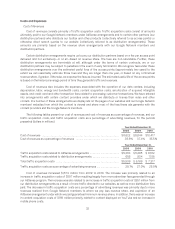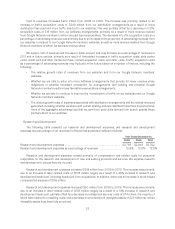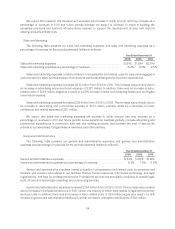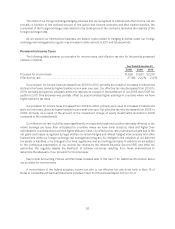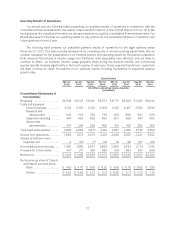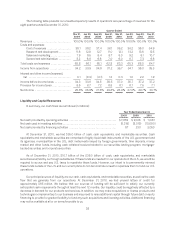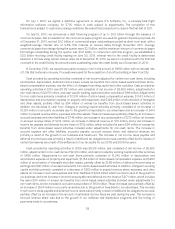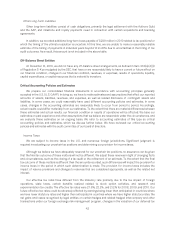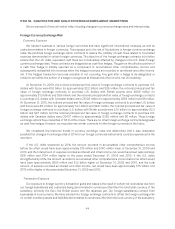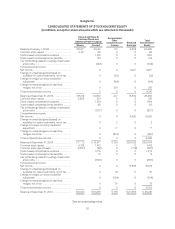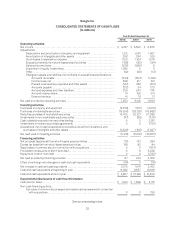Google 2010 Annual Report Download - page 55
Download and view the complete annual report
Please find page 55 of the 2010 Google annual report below. You can navigate through the pages in the report by either clicking on the pages listed below, or by using the keyword search tool below to find specific information within the annual report.Other Long-Term Liabilities
Other long-term liabilities consist of cash obligations, primarily the legal settlement with the Authors Guild
and the AAP, and milestone and royalty payments owed in connection with certain acquisitions and licensing
agreements.
In addition, we recorded additional long-term taxes payable of $289 million in 2010 related to tax positions for
which the timing of the ultimate resolution is uncertain. At this time, we are unable to make a reasonably reliable
estimate of the timing of payments in individual years beyond 12 months due to uncertainties in the timing of tax
audit outcomes. As a result, this amount is not included in the above table.
Off-Balance Sheet Entities
At December 31, 2010, we did not have any off-balance sheet arrangements, as defined in Item 303(a)(4)(ii)
of Regulation S-K promulgated by the SEC, that have or are reasonably likely to have a current or future effect on
our financial condition, changes in our financial condition, revenues, or expenses, results of operations, liquidity,
capital expenditures, or capital resources that is material to investors.
Critical Accounting Policies and Estimates
We prepare our consolidated financial statements in accordance with accounting principles generally
accepted in the U.S. (U.S. GAAP). In doing so, we have to make estimates and assumptions that affect our reported
amounts of assets, liabilities, revenues, and expenses, as well as related disclosure of contingent assets and
liabilities. In some cases, we could reasonably have used different accounting policies and estimates. In some
cases, changes in the accounting estimates are reasonably likely to occur from period to period. Accordingly,
actual results could differ materially from our estimates. To the extent that there are material differences between
these estimates and actual results, our financial condition or results of operations will be affected. We base our
estimates on past experience and other assumptions that we believe are reasonable under the circumstances, and
we evaluate these estimates on an ongoing basis. We refer to accounting estimates of this type as critical
accounting policies and estimates, which we discuss further below. We have reviewed our critical accounting
policies and estimates with the audit committee of our board of directors.
Income Taxes
We are subject to income taxes in the U.S. and numerous foreign jurisdictions. Significant judgment is
required in evaluating our uncertain tax positions and determining our provision for income taxes.
Although we believe we have adequately reserved for our uncertain tax positions, no assurance can be given
that the final tax outcome of these matters will not be different. We adjust these reserves in light of changing facts
and circumstances, such as the closing of a tax audit or the refinement of an estimate. To the extent that the final
tax outcome of these matters is different than the amounts recorded, such differences will impact the provision for
income taxes in the period in which such determination is made. The provision for income taxes includes the
impact of reserve provisions and changes to reserves that are considered appropriate, as well as the related net
interest.
Our effective tax rates have differed from the statutory rate primarily due to the tax impact of foreign
operations, state taxes, certain benefits realized related to stock option activities, and research and
experimentation tax credits. The effective tax rates were 27.8%, 22.2%, and 21.2% for 2008, 2009, and 2010. Our
future effective tax rates could be adversely affected by earnings being lower than anticipated in countries where
we have lower statutory rates and higher than anticipated in countries where we have higher statutory rates, the
net gains and losses recognized by legal entities on certain hedges and related hedged intercompany and other
transactions under our foreign exchange risk management program, changes in the valuation of our deferred tax
42


